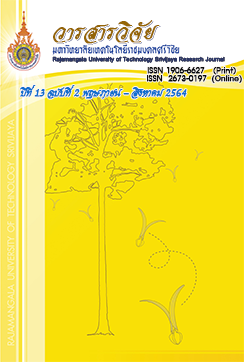Effects of Vermicompost and Water Fern (Azolla pinnata) on Growth of Green Oak Lettuce (Lactuca sativa)
Keywords:
vermicompost fertilizer, water fern, green oak lettuce, soil cultureAbstract
Recently, smart farmers focus on safety vegetable production and consumers give more priority to product quality. Then, the aim of this research is to study and compare the growth of green oak lettuce (Lactuca sativa) on soil with different fertilizers which included 7 treatments: 1) vermicompost, 2) water fern,
3) vermicompost with water fern, 4) vermicompost water extracts, 5) vermicompost with vermicompost water extracts, 6) chemical fertilizer and 7) without fertilizer (control). The results showed that the soil with vermicompost and water fern added had the highest growth rate of green oak lettuce. This treatment had the least nitrate accumulation level of 0.68 mg/g of dry weight. Also, the rate of contamination of bacterial gastrointestinal pathogens, Escherichia coli, was less than 100 CFU/g. In addition, nitrogen fixing bacteria, isolate ME02, in the vermicompost showed higher ammonia concentration at OD560 of 1.0±0.0, compared to well-known nitrogen fixing bacteria, Azotobacter vinelandii (controlled bacteria). Based on morphological and physiological characteristics and biochemical taxonomy, there was a high possibility that isolate ME02 was classified as a member of the genus Azotobacter which was plant growth-promoting bacteria. Therefore, green oak growing in soil with vermicompost and water fern not only produces good quality of salad vegetable but also reduce bacteria contamination that caused gastrointestinal infection and reduce low level of nitrate accumulation. In conclusion, it is recommended to use vermicompost mixed with water fern to grow salad vegetable and others of soil-based crops.
References
Bhosale, H.J., Kadam, T.A. and Bobade, A.R. 2013. Identification and production of Azotobacter vinelandii and its antifungal activity against Fusarium oxysporum. Journal of Environmental Biology 34(2): 177-182.
Bhuvaneshwari, K. and Singh, P.K. 2015. Response of nitrogen-fixing water fern Azolla biofertilization to rice crop. 3 Biotech 5(4): 523-529.
Bisen, P.S., Debnath, M. and Prasad, G.B.K.S. 2012. Microbes: Concepts and Applications. 1st ed. Wiley-Blackwell Publishing, Malden.
Cappuccino, J.G. and Sherman, N. 1992. Microbiology: A Laboratory Manual. 3rd ed. Benjamin/Cummings Pub. Co., Redwood City, CA.
Cataldo, D.A., Haroon, M., Schrader, L.E. and Youngs, V.L. 1975. Rapid colorimetric determination of nitrate in plant tissue by nitration of salicylic acid. Communications in Soil Science and Plant Analysis 6(1): 71-80.
Department of Medical Sciences, Ministry of Public Health. 2017. Standard for microbiological quality of foods and food containers (Issue 3). Available Source: http://e-library.dmsc.moph.go.th/ebooks/files/micro-ISBN60.pdf, March 12, 2020. (in Thai)
Dias, J.S. 2012. Nutritional quality and health benefits of vegetables: A review. Food and Nutrition Sciences 3: 1354-1374.
Dominguez, J., Edwards, C.A. and Ashby, J. 2001. The biology and population dynamics of Eudrilus eugeniae (Kinberg) (Oligochaeta) in cattle wastes. Pedobiologia 45: 341-353.
European Commission. 2011. Commission Regulation (EU) No 1258/2011 of 2 December 2011 amending Regulation (EC) No 1881/2006 as regards maximum levels for nitrates in foodstuffs. (Online). Available Source: https://eurlex.europa.eu/LexUriServ/ LexUriServ.do?uri=OJ:L: 2011:320:0015:0017:EN:PDF, May 23, 2019.
Gruda, N., Qaryouti, M.M. and Leonardi, C. 2013. Growing media, pp. 271-302. In Baudoin, W., Nono-Womdim, R., Lutaladio, N., Hodder, A., Castilla, N., Leonardi, C., De Pascale, S. and Qaryouti, M., eds. Good Agricultural Practices for Greenhouse Vegetable Crops: Principles for Mediterranean Climate Areas. Food and Agriculture Organization of The United Nations, FAO, Rome.
Holt, J.G., Krieg, N.R., Sneath, P.H.A., Staley, J.T. and Williams, S.T. 2000. Bergey’s Manual® of Determinative Bacteriology. 9th ed. Lippincott Williams & Wilkins, Philadelphia, PA.
Hussain, A., Iqbal, K., Aziem, S., Mahato, P. and Negi, A.K. 2014. A review on the science of growing crops without soil (soilless culture) - A novel alternative for growing crops. International Journal of Agriculture and Crop Sciences 7(11): 833-842.
Klangkongsub, S. and Sohsalam, P. 2013. Vermicompost production by using tomato residue and yard waste. Journal of Medical and Bioengineering 2(4): 270-273.
Nam, K.W. and Yoon, D.H. 2008. Usage of Azolla spp. as a biofertilizer on the environmental-friendly agriculture. Korean Journal of Plant Research 21(3): 230-235.
Pathma, J. and Sakthivel, N. 2012. Microbial diversity of vermicompost bacteria that exhibit useful agricultural traits and waste management potential. SpringerPlus 1: 26. doi: 10.1186/2193-1801-1-26.
Sinha, R.K., Agarwai, S., Chauhan, K. and Valani, D. 2010. The wonders of earthworms & its vermicompost in farm production: Charles Darwin’s friends of farmers’, with potential to replace destructive chemical fertilizers from agriculture. Agricultural Sciences 1(2): 76-94.
Tangsombatvichit, P. and Ketrot, D. 2018. The quality of vermicompost from sweet potato crop wastes and its impact on growth promotion of Brassica chinensis. RMUTSB Academic Journal (Science and Technology) 6(2): 124-133. (in Thai)
Tangsombatvichit, P., Chupong, S. Ketrot, D. and Boonlerthirun, K. 2016. The management of organic wastes produced vermicompost using earthworm Eudrilus eugeniae and effects of vermicompost on growth of Helianthus annuus, pp. 1-4. In Proceedings of 5th International Conference on Food, Agricultural and Biological Sciences (ICFABS-2016). International Association of Chemical, Biological & Medical Sciences Researchers, Bangkok.
Downloads
Published
How to Cite
Issue
Section
License
The content and information in the article published in Journal of Rajamangala University of Technology Srivijaya It is the opinion and responsibility of the author of the article. The editorial journals do not need to agree. Or share any responsibility.







